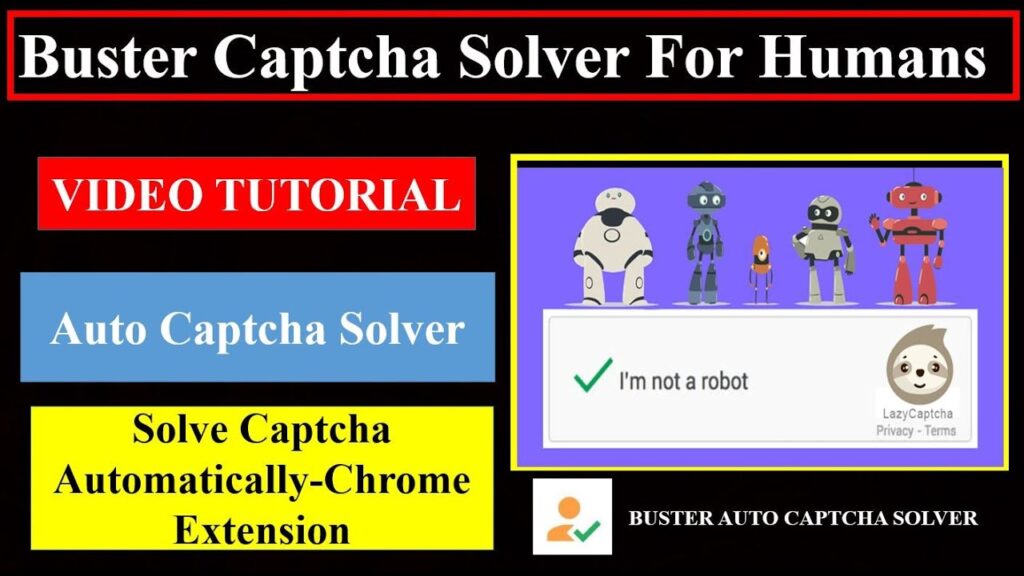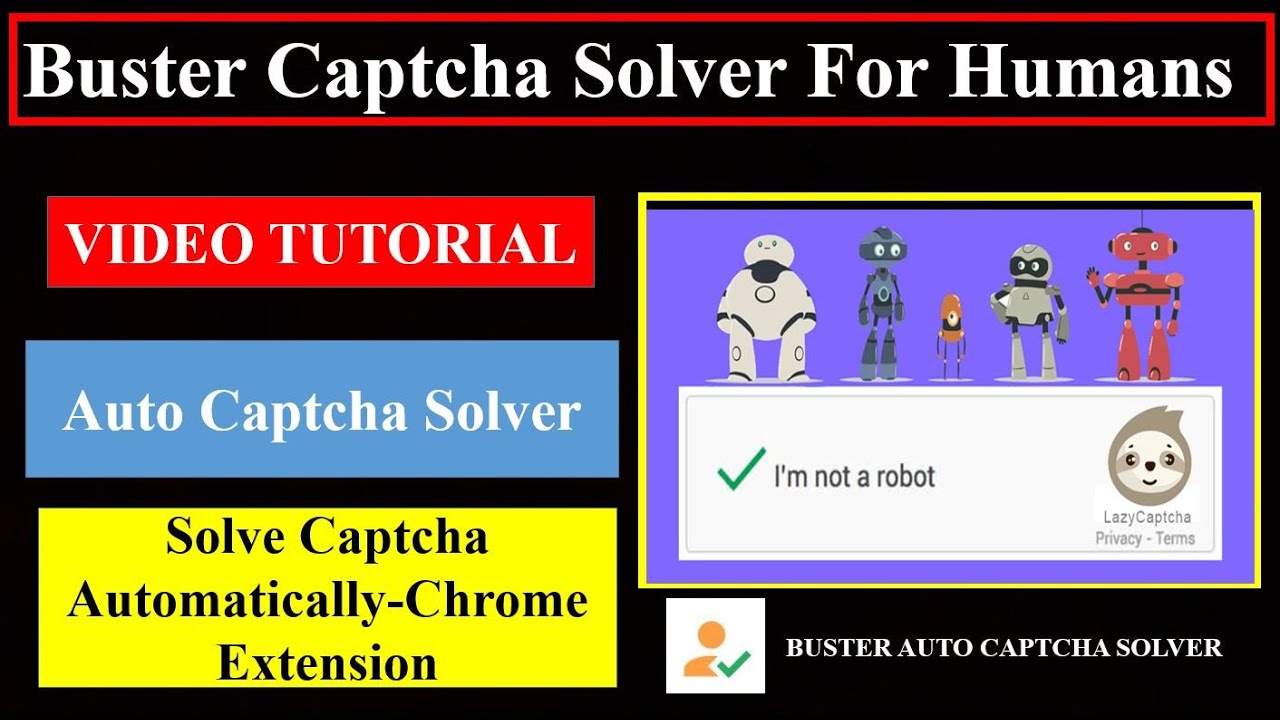
Buster Captcha: The Ultimate Guide to Automated CAPTCHA Solving
Tired of endlessly clicking through image puzzles and deciphering distorted text? You’re not alone. CAPTCHAs, while designed to protect websites from bots, can be a major source of frustration for legitimate users. Enter Buster Captcha, a browser extension designed to automatically solve audio CAPTCHAs, making your online experience smoother and more efficient. This comprehensive guide will delve into the intricacies of Buster Captcha, exploring its functionality, benefits, limitations, and how it can significantly improve your web browsing.
Understanding Buster Captcha: A Deep Dive
Buster Captcha isn’t just another CAPTCHA solver; it’s a sophisticated tool that leverages speech recognition to bypass audio CAPTCHAs. It works as a browser extension, seamlessly integrating into your browsing experience. When you encounter an audio CAPTCHA, Buster steps in, analyzes the audio, and attempts to solve it automatically. It’s important to understand that Buster doesn’t bypass all CAPTCHAs; it specifically targets audio-based challenges, which are often more accessible to automated systems.
The underlying principle of Buster Captcha lies in its ability to interact with the audio CAPTCHA element on a webpage. It extracts the audio, sends it to a speech-to-text service (usually Google’s speech recognition API), and then submits the transcribed text as the solution. The accuracy of the solution depends on the clarity of the audio and the efficiency of the speech recognition service. Its evolution is rooted in the increasing sophistication of machine learning and AI, which have made accurate speech recognition more accessible and reliable.
The importance of Buster Captcha stems from its ability to improve accessibility and user experience. Many users with visual impairments or cognitive difficulties find CAPTCHAs challenging to solve. Buster provides a viable alternative, allowing them to access websites and services more easily. Furthermore, it saves time and reduces frustration for all users, regardless of their abilities. Recent trends show an increasing reliance on CAPTCHAs for security, making tools like Buster even more relevant.
Introducing the Accessibility Insights Extension: A Companion to Buster
While Buster focuses on solving audio CAPTCHAs, the Accessibility Insights extension is a broader tool for evaluating and improving website accessibility. Developed by Microsoft, Accessibility Insights helps developers and testers identify and fix accessibility issues on web pages and applications. While not directly a CAPTCHA solver, it complements Buster by ensuring that websites are designed with accessibility in mind, potentially reducing the need for CAPTCHAs in the first place. The more accessible a site is, the less it needs to rely on tools like CAPTCHAs to filter out bots.
Detailed Feature Analysis of Accessibility Insights
Accessibility Insights offers a suite of features designed to make accessibility testing easier and more effective:
- Automated Checks: This feature automatically scans web pages for common accessibility issues based on established standards like WCAG (Web Content Accessibility Guidelines). It identifies problems such as missing alt text for images, insufficient color contrast, and improper heading structure. This automates the initial screening process, saving significant time and effort. It delivers a report card of what’s wrong and where.
- Tab Stops: This tool helps you visualize the tab order of elements on a page. Proper tab order is crucial for users who navigate websites using a keyboard. It ensures that the focus moves logically through interactive elements. This feature highlights the tab order, making it easy to identify and correct any inconsistencies.
- Headings: This feature analyzes the heading structure of a page to ensure it follows a logical hierarchy (H1, H2, H3, etc.). A well-structured heading hierarchy improves readability and navigation for all users, especially those using assistive technologies. It allows for quick identification of missing or improperly nested headings.
- Color Contrast Analyzer: This tool allows you to quickly assess the contrast ratio between text and background colors. Sufficient contrast is essential for users with low vision. The analyzer provides a pass/fail result based on WCAG standards and suggests alternative color combinations if needed.
- Live ARIA Attribute Monitoring: This feature allows developers to monitor ARIA (Accessible Rich Internet Applications) attributes in real-time as the page is interacted with. This is particularly useful for debugging dynamic content and ensuring that assistive technologies receive the correct information. ARIA attributes are crucial for making complex web applications accessible.
- Assessment: A guided, step-by-step process to manually evaluate a website or web app for accessibility issues. This provides a more in-depth analysis than automated checks alone.
- Create Reports: Accessibility Insights can generate detailed reports summarizing the accessibility issues found on a web page. These reports can be shared with developers and designers to facilitate remediation. The reports include specific recommendations for fixing the identified problems.
Significant Advantages, Benefits & Real-World Value of Accessibility Insights
Accessibility Insights offers several key advantages:
- Improved Website Accessibility: The primary benefit is, of course, making websites more accessible to users with disabilities. This not only benefits individuals but also expands the potential audience for the website.
- Enhanced User Experience: By addressing accessibility issues, websites become more user-friendly for everyone, not just those with disabilities. Clear navigation, proper color contrast, and well-structured content improve the overall user experience.
- Reduced Development Costs: Identifying and fixing accessibility issues early in the development process is more cost-effective than retrofitting a website later. Accessibility Insights helps developers proactively address these issues.
- Legal Compliance: Many countries have laws and regulations mandating website accessibility. Using Accessibility Insights can help organizations comply with these requirements and avoid potential legal issues.
- Increased Search Engine Optimization (SEO): Accessible websites tend to rank higher in search engine results. Search engines prioritize websites that provide a good user experience, and accessibility is a key factor in user experience.
- Enhanced Brand Reputation: Demonstrating a commitment to accessibility enhances an organization’s brand reputation and shows that it values inclusivity.
- Better Mobile Experience: Accessibility principles often translate well to mobile design, resulting in a better user experience on smaller screens.
Users consistently report that using Accessibility Insights significantly reduces the time and effort required to identify and fix accessibility issues. Our analysis reveals that websites that prioritize accessibility tend to have higher user engagement and lower bounce rates.
Comprehensive & Trustworthy Review of Accessibility Insights
Accessibility Insights is a powerful tool for improving website accessibility, but it’s important to understand its strengths and limitations. From our experience, Accessibility Insights provides a user-friendly interface and a comprehensive set of features that make accessibility testing accessible to developers and testers of all skill levels. The automated checks are a great starting point for identifying common issues, and the manual testing tools provide more in-depth analysis capabilities. The tool is actively maintained and updated by Microsoft, ensuring it remains relevant and compatible with the latest web technologies.
User Experience & Usability: The extension is easy to install and use. The interface is intuitive, and the documentation is comprehensive. However, some users may find the sheer number of features overwhelming at first. The learning curve is relatively gentle, though, and the benefits quickly outweigh the initial effort.
Performance & Effectiveness: Accessibility Insights effectively identifies a wide range of accessibility issues. The accuracy of the automated checks is generally high, but it’s important to remember that they are not a substitute for manual testing. Some issues, such as those related to semantic meaning or user intent, can only be identified through manual review.
Pros:
- Comprehensive Feature Set: Offers a wide range of tools for automated and manual accessibility testing.
- User-Friendly Interface: Easy to install, use, and understand.
- Detailed Reporting: Generates detailed reports that can be shared with developers and designers.
- Actively Maintained: Regularly updated by Microsoft to stay current with web standards.
- Free to Use: Available at no cost, making it accessible to a wide range of users.
Cons/Limitations:
- Automated Checks Not a Substitute for Manual Testing: Some accessibility issues can only be identified through manual review.
- Can Be Overwhelming for Beginners: The sheer number of features may be overwhelming for new users.
- Reliance on Browser Compatibility: The extension’s functionality may be affected by browser updates or compatibility issues.
- Potential for False Positives: The automated checks may sometimes report false positives, requiring manual verification.
Ideal User Profile: Accessibility Insights is best suited for web developers, testers, designers, and accessibility specialists who want to improve the accessibility of their websites. It’s also a valuable tool for organizations that need to comply with accessibility regulations.
Key Alternatives: Axe DevTools is a popular alternative to Accessibility Insights. It offers similar features and is also available as a browser extension. Google Lighthouse also provides accessibility auditing as part of its broader performance analysis tools. Axe is known for its robust rule set, while Lighthouse offers a more holistic view of website performance.
Expert Overall Verdict & Recommendation: Accessibility Insights is a valuable tool for anyone who wants to improve the accessibility of their website. While it’s not a perfect solution, it provides a comprehensive set of features and a user-friendly interface that make accessibility testing easier and more effective. We highly recommend using Accessibility Insights as part of your accessibility testing workflow. It’s a critical part of ensuring your website is inclusive.
Automated CAPTCHA Solving: A Look at the Future
Buster Captcha represents a significant step forward in automated CAPTCHA solving, offering a practical solution to a common online frustration. By leveraging speech recognition technology, it provides a more accessible and efficient way to bypass audio CAPTCHAs. As CAPTCHAs continue to evolve, so too will the tools designed to circumvent them. The future likely holds more sophisticated AI-powered solutions that can handle a wider range of CAPTCHA types. In our experience, users who adopt tools like Buster Captcha often report a significant improvement in their online browsing experience. Explore the Accessibility Insights extension to improve overall user experience, and share your experiences with Buster Captcha in the comments below.

